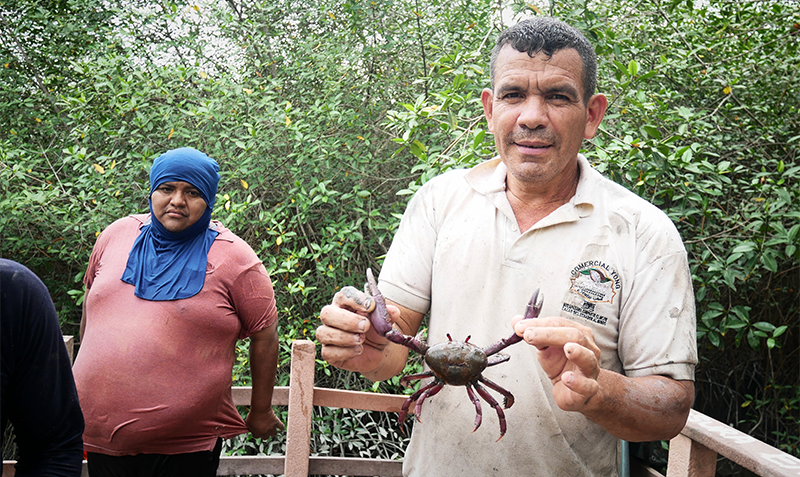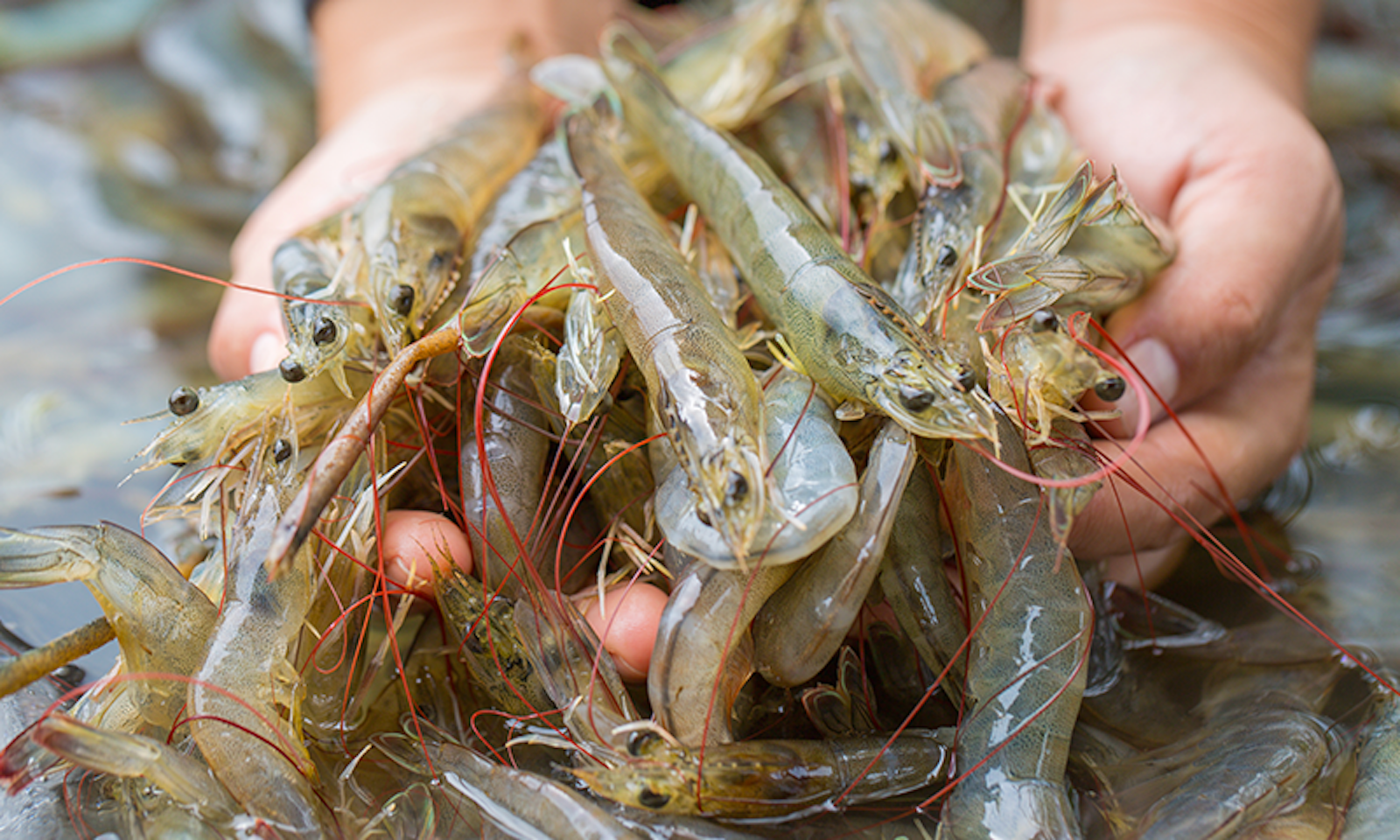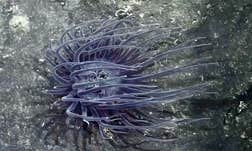Cristhian Castro sinks knee-deep into grayish mud. The endless tangle of aerial roots around him makes mangrove trees look as if they are standing on legs, ready to run off at any moment. Castro, 39, has been navigating this muddy maze in Ecuador’s Guayas River estuary six days a week for more than 25 years, hunting for delicious treasures. He is a cangrejero—artisanal crab catcher—and a fisherman, just like his father, and his father’s father.
“We, the people who are here, living by the riverbanks, in the mangroves, we have a great love for nature,” says Castro. “Nature here has allowed us to dress and feed ourselves, and even that our children can study.” Castro is the president of the Puerto Envidia Association of Crabbers and Fishermen, and his group, along with other artisanal fishing associations, is increasingly at the forefront of the fight to protect the estuary’s ecosystem.
Spilling across approximately 4,600 square miles, the Guayas River estuary is the largest on the Pacific coast of South America. Its network contains 23 tributaries, dozens of small islands, tidal flats, and around 60,800 hectares of mangrove forests that jut into the Gulf of Guayaquil. The city of Guayaquil, with almost 2.7 million inhabitants, sits at the estuary’s upper part, where the Daule and the Babahoyo rivers meet to form the Guayas.
The value of Ecuador’s shrimp exports is $5 billion, making it one of the shrimp capitals of the world.
Guayaquil is a city of superlatives: It’s Ecuador’s largest city, biggest port, most important economic hub—and it is also the planet’s fourth-most vulnerable city to future flooding due to climate change.1 According to Climate Central, an independent organization of climate scientists and journalists, most of the estuary and big chunks of Guayaquil could be underwater or regularly flooded by the end of the century unless the region improves its resilience. A 2013 study in Nature Climate Change estimates that even under a mild future climate scenario—about a 7.8-inch sea-level rise by 2050—the city’s average annual losses from flooding could reach almost $3.2 billion, even if it bolsters its defenses.1
Guayaquileños were shaken to the core when the study came out, and the municipality has since been feverishly drawing up plans and protocols to protect the city, including revamping the city’s waste management system to reduce street gutter blockage, constructing reservoirs, pumps, and walls, and creating more green spaces that would soak up excess water.

A key to climate resilience is the tangly mangroves. According to climate change researchers, ecologists, economists, and crab catchers like Castro, the tightly woven roots and branches of mangroves can blunt storms and large waves, and halt rising waters, providing a living line of defense against climate change for people, homes, and businesses. “In the entire regional ecosystem, the single most underpinning flora or fauna is the mangrove. It’s the keystone species for the entire non-urban Guayas estuary system,” says Stuart Hamilton, chair of the Department of Coastal Studies at East Carolina University in the United States.
Like estuaries around the world, the Guayas River estuary was born where the river meets the sea. In this tidal zone, the river’s freshwater mixes with the salty ocean, resulting in brackish water which creates unique wetlands. Depending on geography and climate, many types of habitats can form in an estuary: salt marshes, mudflats, reefs, and, in the case of Ecuador, mangrove forests. Estuaries are nursing grounds for marine life, pitstops for migrating birds, and can capture massive quantities of CO2 10 times faster—and store three to five times more carbon—than a tropical forest of the same size. As rivers deliver and distribute sediments, estuarine ecosystems act as natural dams, trapping the sand, clays, and gravel and mixing them with plants, roots, and other organic matter to literally build the soil they grow on, and—crucially for coastal communities and cities such as Guayaquil—to act as buffer zones, standing in the way of storms, floods, tsunamis, and rising sea levels.
The brackish shallows of the Guayas River estuary also make perfect breeding grounds for industrial shrimp farming—which has given birth to a major conflict. The booming international industry, important to the local economy, threatens the Guayas River estuary, along with the livelihood and culture of fishermen like Castro. As mangroves are logged to make way for shrimp farms, the estuary’s natural bulwark against climate change is falling.
Ecuador’s love affair with commercial shrimp farming started in the 1970s, as it did elsewhere in the world. The government gave out the first concession to turn a stretch of coastal land into a shrimp farm in 1975, and ever since, the industry’s trajectory has gone through the roof.
Today, shrimp is one of Ecuador’s main exports, along with crude petroleum and bananas. The value of the country’s shrimp exports grew from $850 million in 2010 to $5.32 billion in 2021, making Ecuador, alongside India, one of the two shrimp kings in the world. A lot of these exports go to the U.S.: An average American eats more than 4 pounds of shrimp per year,2 and 37 percent of it comes from Ecuador,3 according to the National Oceanic and Atmospheric Administration, a branch of the U.S. Department of Commerce. Shrimp farming makes this level of consumption possible: Farmed shrimp is, on average, three times cheaper than wild-caught.
In a 2021 interview with The Fish Site, an aquaculture industry news outlet, José Antonio Camposano, the president of Ecuador’s National Chamber of Aquaculture (CNA), which represents the country’s shrimp and other aquaculture sectors, said that the shrimp farm industry, which employs around 261,000 people in the country, represented about 4 percent of the country’s GDP in 2020.4
Estuaries can capture CO2 10 times faster—and store three to five times more carbon—than a forest of the same size.
A shrimp farm needs a warm climate, a constant supply of brackish or sea water, and, ideally, no trees. Mangroves interfere with the efficient spacing of a shrimp farm’s nurseries and “grow-out” ponds, where shrimp mature, complicating aeration and access. Around the globe, large-scale commercial shrimp aquaculture has often led to mangrove deforestation5—in Indonesia, for example, 70 percent of mangrove forests have been damaged by commercial shrimp farming, according to the Global Mangrove Alliance—and Ecuador is no exception.
Between 1969 and 2018, about 70 percent of the more than 159,000 hectares of mangrove that once covered the Gulf of Guayaquil were lost, mostly to shrimp farms, according to Wendy Chávez, an economist and environmental management consultant from Guayaquil.6 In 1999, Ecuador gradually began to introduce laws to protect mangroves. They are now the property of the state and can only be utilized sustainably via state-issued and regulated concessions. Fines for mangrove deforestation are more than $89,000 per hectare, and shrimp farmers are also required to carry out mangrove reforestation based on their size, between 10 and 30 percent of their concession land.
That’s on paper. In practice, these laws and regulations are rarely implemented and the political favor skews in support of shrimp farmers. In April 2022, Ecuadorian President Guillermo Lasso issued a new decree that allows illegal shrimp farms to legalize with relative ease, even if they had previously cut down protected mangroves to make space. And illegal logging continues, says Geovanny Chalén, crabber and former president of the Río de Aguas Vivas artisanal fishing association. Between 2011 and 2021, Chalén’s association reported 15 cases, including the deforestation of over 40 hectares on the island of Los Chalenes in 2020. “A lot of mangroves are still being destroyed,” he says.
Leonardo Mariduena, CNA’s environment director, wrote in a June 2021 article published in Revista AQUACULTURA, CNA’s monthly magazine, that CNA reported instances of illegal mangrove loggings to the Ministry of Environment. “However,” he continued, the mangroves are “a colonizing plant formation, which doesn’t allow on many occasions access to water for the pumping stations. There is no other remedy than selective pruning, endorsed by the environmental authority.” Despite repeated requests, CNA officials and shrimp industry representatives in Ecuador refused to comment for this article.
In April, I made the 250-mile journey from the capital, Quito, to see the estuary, its people, and the mangroves that connect and divide them. After descending through a cloudbank from the Andes on a serpentine road that seemed to go on forever, I’d ignorantly expected to see mangroves right away. Instead, I was greeted by fields of rice, banana, and cacao plantations, all ruled by giant haciendas. One banana plantation even had its own private airport. Only when the road leveled out into a highway that runs parallel to the Churute Reserve could I squint to see in the distance the thin dark green line that was the edge of the mangrove forest.
I turned left at a small roadside restaurant with a hand-scribbled sign that read “Crab Meat For Sale,” and swiftly found myself in a land of contrast. Humble wooden shacks and kitschy multi-story houses alternated along the dirt road. The air was hot and humid, laced with a faint smell of the sea. I passed a family swimming in a stream between rice fields, and another family taking a dip in a slick blue-tiled pool.

There are many small communities in the estuary,6 some 10,000 people in total spread across the various islands. Some villages take up to two hours to reach by boat from Guayaquil. This isolation translates into a lack of everything—potable water, electricity, sewage system, schools, and health centers. “The municipality [of Guayaquil] argues that they are only responsible to cover the basic needs and services for the urban areas, and the communities in the Gulf of Guayaquil are located in the rural areas,” says Chávez.
Lack of support from provincial authorities means that the rural folk rely on NGOs for generators or solar panels, and for water, on shrimp farms, which the farms deliver to the local communities as part of their effort to establish amity. Meanwhile, I took a wrong turn. Instead of the mangroves, I came face-to-face with a shrimp farm. There was pool after still pool, separated by narrow low dirt walls upon which sat generators and pipes that pumped nutrients into the water. Only a couple of warehouses broke the seemingly bleak landscape. Not a single tree in sight, mangrove or any other kind, but there was a watchtower, which, I was told later, was essential as shrimp thefts can rack up hefty damages.
In economic terms, crabbers are not a priority for Ecuador. Crabs are mostly sold domestically. The Gulf of Guayaquil makes around $40 million annually from catching, selling, and preparing crabs, while national exports amount to a meager $81,000 to $108,000 a year. Meanwhile, Castro and other artisanal fishermen depend on the survival of the mangroves. Many of the species they catch and collect, such as catfish, cockles, clams, but especially red crabs (Ucides occidentalis) and mouthless crabs (Cardiosoma Crassum), are unique to the mangroves and the estuary. “No mangroves, no crabs.” Hamilton sums up simply. “They’re fundamental, so the more you lose of them, the more problems you’re going to have with wild catch. Crabs are going to decrease, mollusks are going to decrease.”
Mangroves are logged because they interfere with the spacing of a shrimp farm’s nurseries and ponds.
Castro’s workday typically starts at 5 a.m. After a hearty breakfast of rice with chicken, fish, or seafood with a side of green plantain mashed with scrambled eggs, he sets out in his Ranger motorcycle from his home in El Mango, a community of a few dozen houses along the Troncal de La Costa highway, for a small, wooden pier just past the entrance of the Churute Mangrove Ecological Reserve, some 12 miles away. He started fishing and crabbing along the snaking estuary coastline at the age of 11, and has witnessed how the shrimp industry, like a tide that never ebbs, has been engulfing the labyrinthine mangrove forests to make way for painfully straight-lined shrimp breeding pools. He and his family used to live next to the mangroves, but the expanding shrimp farms forced them to move away.
The majority of the surviving mangroves have been divided under special mangrove concessions.6 Theoretically, this grants members of crabber and fishermen associations unique access. In exchange, they must become custodians of the forest and carry out regular boat patrolling of the mangroves, especially to report deforestation. “It’s very expensive,” says Chávez. “The only way to do that is really pay for a lot of gasoline and go every day, on your own time.”
Castro says associations have been diligently reporting mangrove logging for years, often taking videos and photos as evidence, but authorities have mostly ignored their reports. Besides, because there is barely any maritime patrol in the estuary, the concession agreements also mean that the associations are responsible for detaining and handling unaffiliated fishers and crabbers.
Under the Socio Bosque Program, which is connected to a United Nations-backed carbon-credit system that allows developed nations to maintain carbon-emission levels by paying developing countries to reduce deforestation, mangrove custodians are receiving some financial support. But the money—between $7,000-15,000 per year per custodian association, depending on the size of their mangrove forest—is far from covering the custodians’ costs. Castro’s association has such a concession, and when he goes crabbing he usually teams up with other crabbers and fishermen so that they can afford to rent a long, slim motorized canoe for $8 per day.
The way Castro and his fellow crabbers track down and catch crabs can only be described as art. But it’s a very dirty kind of art: Crabbers kneel or lie down in the mud, thrust their arms, often shoulder-deep, into the dark tunnels where crabs live, and use long metal hooks to grab onto the animals and drag them out. They can tell which crab they want to catch just by looking at the holes. “We can tell it apart by the trail or footprint of the crab,” says Castro. “Male crabs have a bigger footprint, they leave thicker trails, while the female has finer legs, so their footprints are not so defined on the ground.” Artisanal crabbers also look for holes that are fist-sized or bigger because fishery regulations only allow them to catch males that are larger than 2.9 inches.
The surviving mangroves are helping safeguard the estuary, and, ironically, the shrimpers, from the pollution caused by shrimping. Studies by the University of Guayaquil7 and the environmental group Acción Ecológica8 show that the shrimp farms occasionally discharge untreated water full of biocides, antibiotics, and fertilizers containing nitrogen, phosphorus, and silicate.9 This adds to the approximately 10 to 12 million cubic feet of domestic and industrial waste Guayaquil dumps into the estuary each day, according to a 2015 analysis by EMAPAG-EP, the city’s municipal water and sewage company. The estuary mudflats accumulate and trap various toxins,10 some of which—such as nickel and arsenic—are reaching alarming levels, reports a 2021 study published in the scientific journal Foods. Mangroves act as natural bio-filters, Hamilton explains, and without them, many pollutants would be left loose in the water. “You’ll probably have more harmful alga blooms, more hyper-eutrophication on the water body, more fish kills, and lower water quality,” Hamilton says.
In May, Castro, Chalén, and various leaders of crabber and fishermen associations from the Guayas River estuary met with Gustavo Manrique, Ecuador’s Environment Minister, to discuss the illegal logging of mangrove forests—the first time an Ecuador minister of any kind has met with the crab catchers of the Guayas estuary. Manrique promised to launch an extensive investigation into past and current complaints and resolve the situation, at least in protected areas of the estuary.
Knee-deep in mud amid the snarl of mangrove roots, Castro tells me the meeting was promising. The fishermen had been given a voice in the fate of the estuary, but he remains skeptical about deep-rooted change. One thing is for sure, Castro says, his future, as well as the estuary’s, hinges on a firm decision: to stay and fight. ![]()
Lead image: Phensri Ngamsommitr / Shutterstock
References
1. Hallegatte, S., Green, C., Nicholls, R.J., & Coffee-Morlot, J. Future flood losses in major coastal cities. Nature Climate Change 3, 802-806 (2013).
2. Clark, M. What are we supposed to think about shrimp? The New York Times (2019).
3. van der Pijl, W. India remains the US’s largest supplier of peeled shrimp but Ecuador has taken over as largest supplier of shell-on shrimp. The Shrimp Blog (2022).
4. Fletcher, R. Forging closer links with Ecuador’s shrimp sector. The Fish Site (2021).
5. Ahmed, N., Thompson, S., & Glaser, M. Integrated mangrove-shrimp cultivation: Potential for blue carbon sequestration. Ambio 47, 441-452 (2017).
6. Chávez Paéz, W. Socio-ecological conflicts and the challenges of climate change. Thesis, KU Leuven (2017-2018).
7. Pernia, B., Mero, M., & Cornejo, X. Impactos de la contaminación sobre los manglares de Ecuador. Manglares de Ecuador Universidad de Especialidades Espíritu Santo, Guayaquil, Ecuador (2019).
8. Acción Ecológica. Cuando el mar entra a la tierra. naturalezaconderechos.org (2020).
9. Boyd, C.E., Davis, R.P., & McNevin, A.A. Comparison of resource use for farmed shrimp in Ecuador, India, Indonesia, Thailand, and Vietnam. Aquaculture, Fish and Fisheries 1, 3-15 (2021).
10. De Cook, A., De Troyer, N., Forio, M.A.E., & Garcia Arevalo, I. From mangrove to fork: Metal presence in the Guayas Estuary (Ecuador) and commercial mangrove crabs. Foods10, 1880 (2021).


































